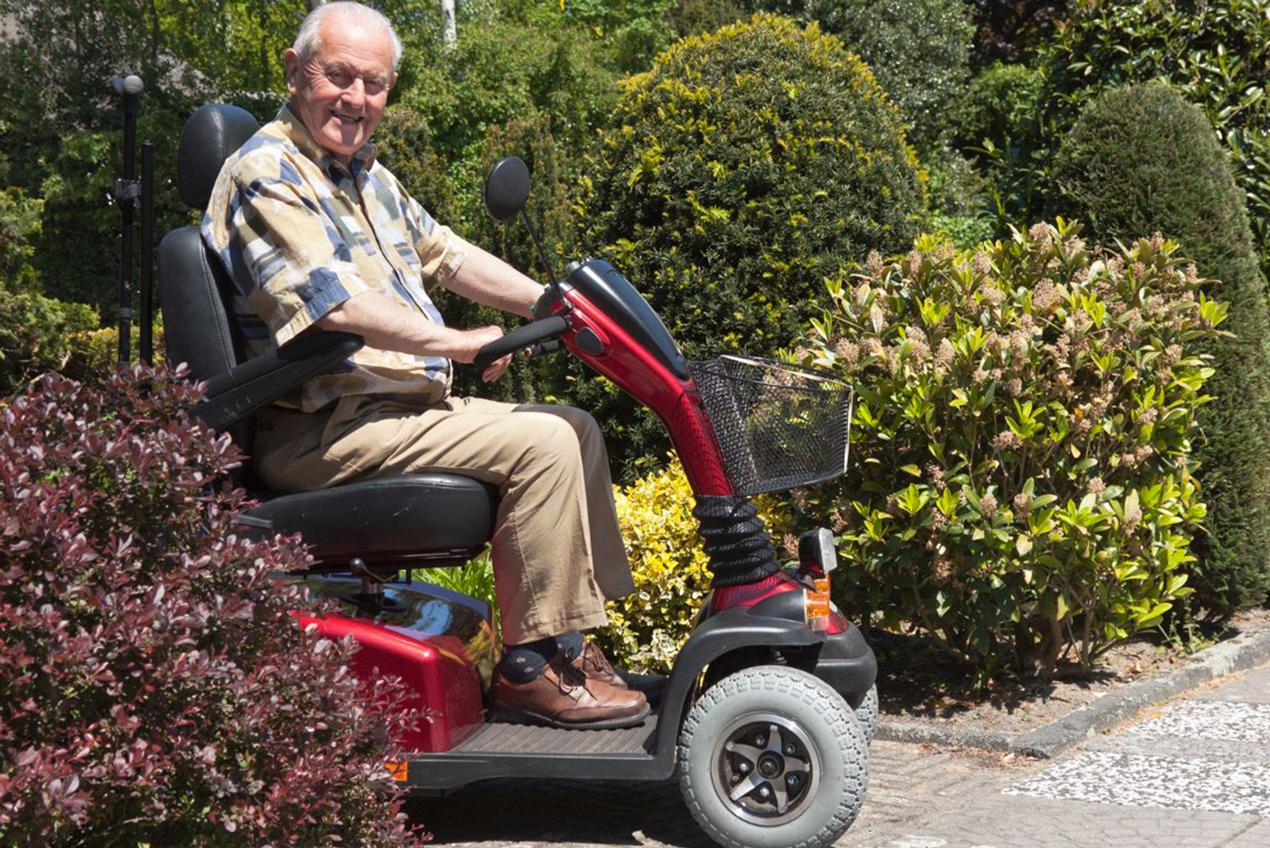Are you a senior or a retiree who has difficulty walking long distances but doesn’t want to give up your daily outings? It might be time to consider purchasing a motorized mobility aid for seniors. Do you live in a private senior residence or are you planning to move into one soon? Here are some tips for choosing the electric scooter (or three-wheeled scooter) that best suits your needs.
Four-Wheel Mobility Scooter vs. Three-Wheel Mobility Scooter
Going out, getting some fresh air, and meeting people is beneficial for the physical and mental health of seniors. As most occupational therapists remind us, it is crucial for elderly people to be able to move around without fearing that they will run out of energy to return home. Four-wheel mobility scooters allow for this mobility without excessive effort.
Motorized mobility aids are divided into three categories: three-wheel scooters, four-wheel scooters, and electric wheelchairs. Electric wheelchairs are intended for people who have lost the use of their legs. Three-wheel and four-wheel scooters, on the other hand, are designed for seniors who can still move short distances with support. Three-wheel scooters are maneuverable in tight spaces due to their single front wheel, but specialists generally prefer four-wheel scooters for their increased stability.
Types of Mobility Scooters
Standard Mobility Scooters
Standard Mobility Scooters Mobility scooters come in several formats: compact, intermediate, and heavy-duty. Compact scooters are convenient in tight spaces, intermediates offer a good balance between maneuverability and stability, while heavy-duty models are ideal for uneven terrain and have a higher weight capacity.
Portable Mobility Scooters
Portable mobility scooters are perfect for traveling by car or plane. They are divided into two categories: disassemblable and foldable. Disassemblable models come apart into several pieces, making them easier to transport. Foldable models, on the other hand, fold up like a suitcase with wheels. Portable mobility scooters generally have shorter battery life and are less comfortable for tall or large individuals.
Technical Specifications to Consider
Quadricycles are equipped with one or two electric motors ranging from 400 to 1500 watts, reaching maximum speeds of 5 to 32 km/h. Models approved by Health Canada do not exceed 20 km/h. The brakes are electromagnetic, automatically stopping the vehicle as soon as the accelerator is released. Batteries can be lead-acid, gel, or lithium-ion. The chosen technology influences the weight, range, and cost of the vehicle. The range can vary from 10 to 80 km per charge, depending on several factors such as motor power, total weight, and terrain.

The Difference Between Your Needs and the Constraints to Assess
It is essential to clearly understand your needs and constraints in order to choose the right mobility scooter. These questions help retailers guide you to the model best suited to your situation.
- What do you wish to do with your mobility scooter?
- Where do you live: in a retirement residence, an apartment, or at your home?
- What type of route do you usually take?
- Do you have access to an elevator?
- Will you need to transport your mobility scooter?
- Where will you store it?

Accessories and Options: A Multitude of Choices
Accessories can make your mobility scooter more practical and comfortable. Some are mandatory for public road use, such as reflectors, headlights, and flags. Others, like mirrors, windshields, or roofs, can make driving easier. You can also add baskets, storage boxes, and holders for canes, walkers, or oxygen tanks.
It is recommended that the senior or retiree who will be using the mobility scooter be present during the purchase to assess their ability to drive and ensure their comfort. A test drive allows them to become familiar with basic maneuvers under the supervision of specialists.
Pricing and Financing, Assistance for Seniors
The price of mobility scooters ranges from $1,850.00 to $10,000.00, depending on the models and accessories chosen. Robust and powerful models are generally more expensive, while portable ones are often more affordable. Some costs may be covered by private health insurance or financing programs such as SAAQ, CNESST, or Veterans Affairs Canada. Additionally, inquire with the Quebec government, which offers programs for seniors with mobility impairments.

Maintenance and Longevity
To maximize the lifespan of your scooter, an annual maintenance is recommended. Technicians inspect and clean the parts and mechanisms for around $100. The tires should be in good condition to avoid accidents and breakdowns.
Road Safety
Quadricycles must travel on bike lanes or sidewalks and must not exceed 10 km/h on the latter. Driving on highways is prohibited, as is driving while impaired, using a cell phone, and wearing headphones. In case of violations, quadricycle drivers, whether senior or not, are subject to the same penalties as other road users.
In conclusion, choosing the right quadricycle requires a precise assessment of your needs and constraints. By considering the technical features, available accessories, and safety regulations, you can find the device that will offer you optimal autonomy and comfort. Remember to consider purchasing in person to ensure a perfect fit for your situation.
If you want to learn more about private residences for seniors and how to find the one that suits your needs, feel free to contact the Bonjour Résidences team. We are here to assist you with your search free of charge. Call us at 1-844-918-1020 to speak with a member of our team.








